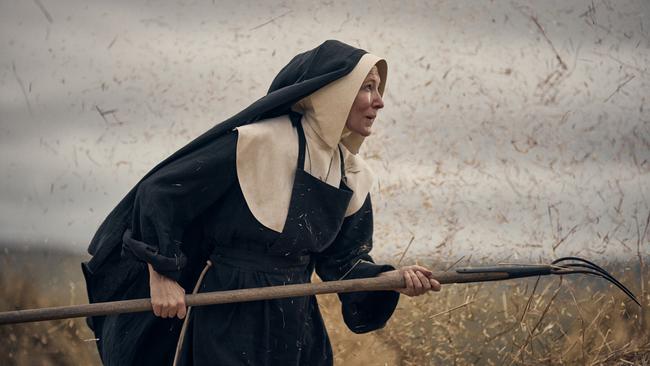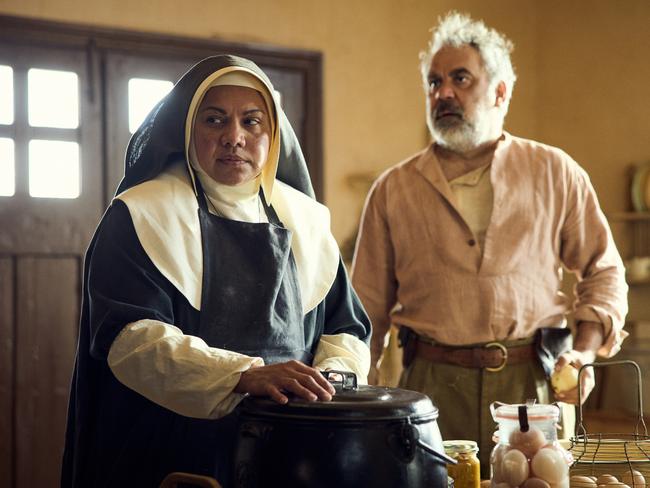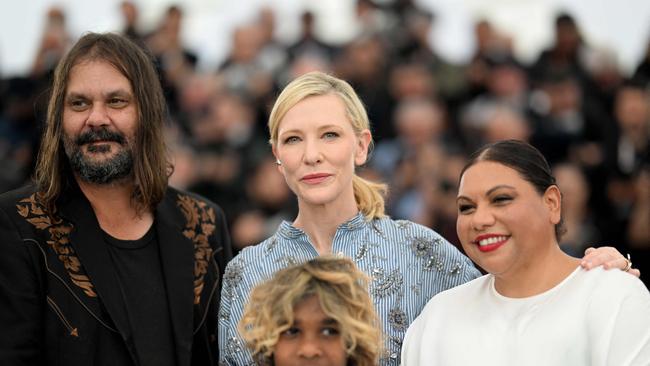The New Boy tackles clash of Catholic and Indigenous belief
How the award-winning actor helped Indigenous director Warwick Thornton turn his personal story into a feature film after 18 years.

The New Boy may be Warwick Thornton’s most personal film yet. Indeed, it’s taken him 18 years to bring the story to the screen.
It was inspired by his childhood experience of being sent to a remote boarding school in New Norcia, the monastery town 130km north of Perth run by Spanish Benedictine monks. It was the first time Thornton, who has Kaytetye heritage and grew up in Alice Springs, had experienced Christian spirituality.
He was initially “freaked out” by images of the crucifixion, but found that, in some ways, Christianity was not so different from the Aboriginal spirituality he’d grown up with. Both involve a faith in the metaphysical or supernatural, and he compares that religious belief with the way children are told about Father Christmas or the tooth fairy.
“If you look at where I come from – Indigenous spirituality – it’s inverted, he says. “There’s a certain age where, through initiation, you’re taught that Santa Claus does exist, and that fairies do exist – this is told to you by an 80-year-old elder.
“So rather than, as a parent, you sit there and tell your kid that Santa Claus doesn’t exist and fairies aren’t real, it’s the other way around with us, actually … And Jesus in that version can even exist, Christianity’s God can exist in that (belief system) with us.”
In The New Boy, Thornton wanted to explore that uneasy intersection between Christianity and Indigenous spirituality that he experienced in his childhood.
Set in the 1940s, the story follows a young Indigenous boy (stunning newcomer Aswan Reid) who a policeman delivers in a potato sack to an outback Benedictine monastery that serves as a mission for orphaned Indigenous children.
The boy had already tried to escape on the journey there, and the officer warns Sister Eileen (played by Cate Blanchett) he is “a bolter” and to watch out for him. Sister Eileen takes the boy under her wing and comes to believe he has strange powers. When a large wooden crucifix is sent from Europe to prevent it being damaged in the war, the boy, who has no name and speaks no English, is so fascinated that he pierces his hands with nails and brings snakes as an offering. Sister Eileen resorts to baptising him as a means of salvation.
Blanchett was at the Cannes Film Festival with Thornton for the film’s world premiere. She and her husband, Andrew Upton, are co-producers of The New Boy, and were instrumental in getting it off the ground. Through discussions between them and Thornton about the screenplay, the central character – a monk in earlier drafts – became Sister Eileen.
“The first time Andrew and I read it, we were really compelled by it,” Blanchett recalls. “We thought this is really mysterious; there was something unknowable in it. It also sparked a really interesting conversation about the story’s potential, like, what if the nun was a priest, and what consequences would that have not only for the narrative, but for the relationship between the other characters and the idea of having a dark secret that they all share in this remote monastery.”
“The script was a little bit numb and dull, and then suddenly Cate came along and tried to set it on fire,” Thornton says. “By her doing that, we kind of created a new film.”
“Sister Eileen is an amazing voice, the voice of God,” he adds. “But she’s in a space where there are cracks beginning to appear in her own faith. So she’s a more porous religious entity, and more available, I think, to what you know. She’s hoping for a miracle in a way. And I suppose the tragic thing is she thinks the new boy might be it.”

Blanchett says: “The interesting thing about organised Western religion is that it’s about the beyond, whereas Indigenous spirituality invariably is connected to now and place. So with organised religion there’s often an avoidance of place, which I think is bizarre.”
At one point in her childhood Blanchett wanted to be a Catholic, because her best friend was at a Catholic primary school. They would talk to each other through the school fence.
“I always wanted to jump over, because all the Catholic kids were always swearing and punching one another, and it seemed more exciting over there,” says Blanchett, who went to a state school.
“Obviously, I knew nothing about the dark recesses of the Catholic Church at that point, but I loved going to mass with her every Sunday, because I loved the ritual and the community, so I was compelled by it.
“And then my father passed away when I was 10 and I spent an entire year waiting for him to return. I went to mass every Sunday in the hope that I would not know that he was not coming back.”
She claps her hands, chuckling at the memory.
“I suppose the thing I find tricky about organised religion is that it expels doubt and preaches certainty. And I think that’s the space that you find Sister Eileen in. They’ve got this collective dark secret, which we have as Australians – you know, the country has been colonised, but we don’t talk about it, we hide it behind the back shed, and we all get on and pretend it’s not happening.
“Then into it comes Indigenous spirituality. So how do we reconcile those two things?”
In some ways the film is about rites of passage, when children grow into adulthood.
“It’s really painful and it’s riddled with mistakes,” Blanchett says. “Watching my children go through it, it feels brutal somehow. I think that we try and protect our children, which is an innate instinct, but the world can be a cruel place and that’s what I found interesting in the movie, that it all takes place in this one location, a secluded monastery, but yet, what is going on? There’s quite a lot of psychological and spiritual turbulence. I think that I would not want to be in my teens again.”
Now based in Britain, Blanchett says she misses Australia “intensely”.
“I think that’s what provoked these long, rambling conversations with Warwick during the pandemic,” she says. “When you live outside Australia, you never leave it. It’s too magnetic. Invariably, as someone who works in the performing arts, in the cinema – Australians are welcomed all over. But we’re always talking about when can we go home. I was really missing it and longing to reconnect with it, but suddenly with everything locking down, I couldn’t go back.”
Blanchett’s conversations with Thornton were like a lifeline. “They were not just about Australia, specifically, but also about the land struggle, the struggle with the connection to the Earth. Eventually the film was sort of a godsend because to go back to South Australia, where we’d filmed Stateless, was really fabulous.”

Deborah Mailman, who plays another nun at the monastery orphanage, Sister Mum, recalls that Aswan loved the idea of not talking in the film. “He’s a very contemplative kid,” she says. “He’s very quiet, very observant, so it wasn’t hard for him.”
The daughter of a Maori mother and an Aboriginal father who was raised in Mount Isa, Mailman says she wasn’t brought up in a particular religion. “I don’t have a religion,” she says.
She has long known Thornton and his buddy, Wayne Blair, who has directed her on The Sapphires and the ABC series Total Control. In The New Boy, he plays George, a caretaker who runs the monastery farm. She recalls there being a sense of family on the film shoot. “It just naturally happened with this. To come together in this way with this story, it’s why I do what I do.”
Mailman had co-hosted the 2015 AACTA Awards ceremony with Blanchett, but The New Boy is the first time she has worked on a film with the actor, who became one of the gang.
“You’ve got very great artists who know their craft, but at the end of the day all the airs and graces are pushed aside,” she says. “There’s work to be done, you know, so the four of us – Cate, me, Waynie and Warwick – we’re all telling the same story. And not only that, we had a responsibility to the young boys in the cast, to look after them and make sure they felt comfortable on set, so they were able to play without feeling embarrassed or anything like that.”
The New Boy arrives in cinemas at a critical time in Australia, with the referendum on the voice to parliament due by the end of the year.
“I think it’s really important,” Mailman says. “Cinematically, films like The New Boy, Bran Nue Dae, The Sapphires, Mystery Road and Total Control are giving us a voice. So that’s part of the conversation, part of that narrative as well. I’m anxious, but also interested to see how the country responds to this.”
Thornton says: “It’s such an interesting dynamic, because people use everything for their own purposes. You know, there’s a right-wing existence in Australia that can actually use this (film) against the voice. And then there’s the Indigenous community that will use it for the voice. People take things and jam them where they need them to be, and it can be really ugly.
“I think what we need is an Australia that wants to know more and to educate itself. It’s like, come on, guys, this country is so beautiful and so important. Why aren’t we wanting to learn more, rather than ‘What’s in it for me?’. I think it’s the right time for the plan, but it’s a dangerous time for Australia. It’s up to people to educate themselves, so come and watch the film and you might learn something about Indigenous history.”
The New Boy is released in cinemas on July 6.




To join the conversation, please log in. Don't have an account? Register
Join the conversation, you are commenting as Logout